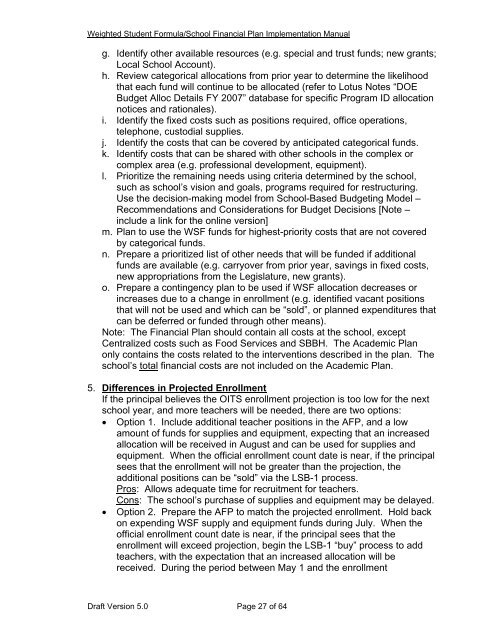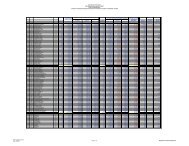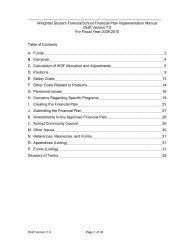2007-08 WSF Implementation Manual - reach
2007-08 WSF Implementation Manual - reach
2007-08 WSF Implementation Manual - reach
Create successful ePaper yourself
Turn your PDF publications into a flip-book with our unique Google optimized e-Paper software.
Weighted Student Formula/School Financial Plan <strong>Implementation</strong> <strong>Manual</strong><br />
g. Identify other available resources (e.g. special and trust funds; new grants;<br />
Local School Account).<br />
h. Review categorical allocations from prior year to determine the likelihood<br />
that each fund will continue to be allocated (refer to Lotus Notes “DOE<br />
Budget Alloc Details FY <strong>2007</strong>” database for specific Program ID allocation<br />
notices and rationales).<br />
i. Identify the fixed costs such as positions required, office operations,<br />
telephone, custodial supplies.<br />
j. Identify the costs that can be covered by anticipated categorical funds.<br />
k. Identify costs that can be shared with other schools in the complex or<br />
complex area (e.g. professional development, equipment).<br />
l. Prioritize the remaining needs using criteria determined by the school,<br />
such as school’s vision and goals, programs required for restructuring.<br />
Use the decision-making model from School-Based Budgeting Model –<br />
Recommendations and Considerations for Budget Decisions [Note –<br />
include a link for the online version]<br />
m. Plan to use the <strong>WSF</strong> funds for highest-priority costs that are not covered<br />
by categorical funds.<br />
n. Prepare a prioritized list of other needs that will be funded if additional<br />
funds are available (e.g. carryover from prior year, savings in fixed costs,<br />
new appropriations from the Legislature, new grants).<br />
o. Prepare a contingency plan to be used if <strong>WSF</strong> allocation decreases or<br />
increases due to a change in enrollment (e.g. identified vacant positions<br />
that will not be used and which can be “sold”, or planned expenditures that<br />
can be deferred or funded through other means).<br />
Note: The Financial Plan should contain all costs at the school, except<br />
Centralized costs such as Food Services and SBBH. The Academic Plan<br />
only contains the costs related to the interventions described in the plan. The<br />
school’s total financial costs are not included on the Academic Plan.<br />
5. Differences in Projected Enrollment<br />
If the principal believes the OITS enrollment projection is too low for the next<br />
school year, and more teachers will be needed, there are two options:<br />
• Option 1. Include additional teacher positions in the AFP, and a low<br />
amount of funds for supplies and equipment, expecting that an increased<br />
allocation will be received in August and can be used for supplies and<br />
equipment. When the official enrollment count date is near, if the principal<br />
sees that the enrollment will not be greater than the projection, the<br />
additional positions can be “sold” via the LSB-1 process.<br />
Pros: Allows adequate time for recruitment for teachers.<br />
Cons: The school’s purchase of supplies and equipment may be delayed.<br />
• Option 2. Prepare the AFP to match the projected enrollment. Hold back<br />
on expending <strong>WSF</strong> supply and equipment funds during July. When the<br />
official enrollment count date is near, if the principal sees that the<br />
enrollment will exceed projection, begin the LSB-1 “buy” process to add<br />
teachers, with the expectation that an increased allocation will be<br />
received. During the period between May 1 and the enrollment<br />
Draft Version 5.0 Page 27 of 64




